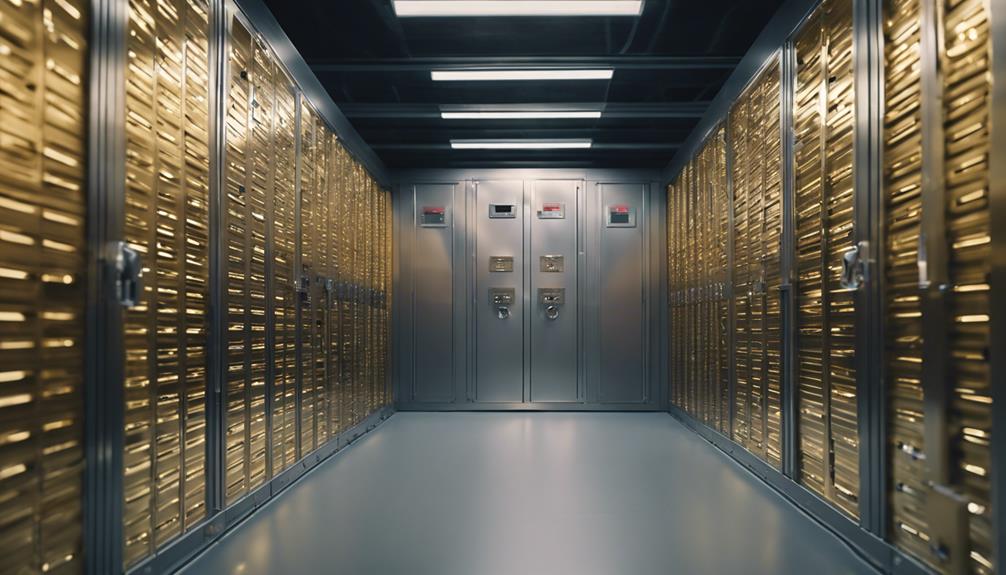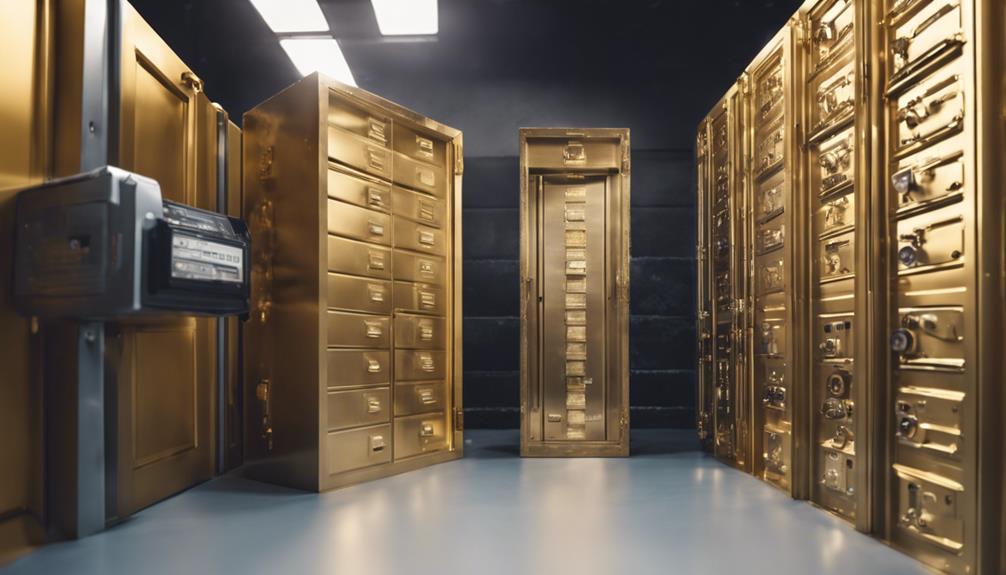When deciding where to store your Gold IRA, the choice between using a custodian or self-managing depends on your level of expertise and preference for control. Professional custodians offer regulatory compliance, security, and investment management services, albeit at higher fees and less hands-on involvement. On the other hand, self-managed options come with lower fees but require more oversight, potentially exposing you to compliance risks. Custodians ensure strict security measures and take care of administrative tasks for added convenience, albeit at a cost. It’s important to consider risk mitigation, asset protection, and costs when selecting storage options that align with your financial goals. Understanding these key factors will help you effectively navigate the complexities of Gold IRA storage.
Key Takeaways
- Professional custodians ensure compliance and offer expertise for secure Gold IRA management.
- Self-management may expose individuals to compliance risks and security vulnerabilities.
- Custodians charge annual fees, while self-managed accounts incur setup and transaction fees.
- Custodial storage provides convenience and peace of mind, while self-managed storage offers more control.
- Professional depositories enhance asset protection and mitigate risks compared to home storage.
Professional Oversight Vs. Control

Balancing between the guidance of professional custodians and the autonomy of self-management is a critical decision for individuals considering Gold IRA storage options. Professional custodians offer expertise and oversight in managing Gold IRAs, ensuring compliance with IRS regulations and storage requirements for precious metals. They provide a level of security and assurance for account owners, handling the complexities of investment choices within the IRA.
On the other hand, self-managed options grant account owners more decision-making power and control over their investments. This allows for direct involvement in selecting and managing investment choices and strategies within the IRA. However, with this increased control comes the responsibility of staying compliant with IRS regulations and storage guidelines without the constant oversight of a professional custodian.
Ultimately, the choice between professional custodians and self-managed options boils down to the level of involvement and expertise the account owner desires, as well as their comfort with managing IRS regulations and investment decisions independently.
Compliance and Security Vs. Self-Management

Maintaining compliance with IRS regulations and evaluating adequate security measures for storing precious metals in Gold IRAs is a crucial factor when assessing the options between custodians and self-management. Here are four key points to contemplate:
- Custodian: Custodians guarantee compliance with IRS regulations and storage standards, offering professional oversight in safeguarding Gold IRA assets.
- Self-management: Self-management necessitates account owners to handle storage and security responsibilities, which could result in compliance risks and insufficient security measures.
- Security measures: Custodians typically implement strict security protocols to safeguard precious metals, while self-management may lack the same level of security expertise and resources.
- Hands-on control: Choosing between a custodian and self-management depends on the preference for hands-on control versus professional guidance in Gold IRA storage options. Individuals must assess the trade-offs between managing their assets independently and entrusting them to a custodian for expert care.
Fee Structure and Costs

Amidst the considerations for establishing a Gold IRA, evaluating the fee structure and associated costs plays a pivotal role in determining the financial impact of custodian-managed versus self-managed options. Custodian-managed Gold IRAs typically have annual fees ranging from $100 to $300 for account maintenance, while self-managed Gold IRAs may incur one-time setup fees of $50 to $100 for establishing the account. Additionally, custodians charge transaction fees of around $40 to $80 per trade in Gold IRAs, which can add up depending on the frequency of trading. On the other hand, self-managed Gold IRAs may involve lower ongoing fees but require the account holder to handle all administrative tasks, which could be a trade-off for some investors. Additionally, custodian-managed Gold IRAs may include additional fees for storage and insurance of precious metals, which should be factored into the overall cost analysis.
| Fees | Custodian-Managed Gold IRAs | Self-Managed Gold IRAs |
|---|---|---|
| Account Maintenance | $100 – $300 annually | Lower ongoing fees |
| Setup Fees | Not applicable | $50 – $100 one-time |
| Transaction Fees | $40 – $80 per trade | Not applicable |
Convenience and Involvement Level

When pondering the convenience and level of involvement in gold IRA storage options, account holders must evaluate the benefits of custodial versus self-managed storage solutions. Here are four key points to ponder:
- Custodial storage: Offers convenience by handling all aspects of gold IRA storage and security, providing a hands-off approach for account holders who prefer peace of mind.
- Self-managed storage: Requires more engagement from the account owner in overseeing security and storage arrangements, allowing for more control over storage decisions.
- Peace of mind: Custodial storage may provide peace of mind for those who prefer a hands-off approach to managing their gold IRA investments.
- Control and cost: Self-managed storage allows for more control over storage decisions and potentially lower storage fees for proactive account owners.
The level of involvement in choosing between custodial and self-managed storage can greatly impact the overall experience and satisfaction with a gold IRA.
Risk Mitigation and Asset Protection

Considering the intricate administrative responsibilities and potential risks associated with self-managed Home Storage Gold IRAs, account holders must prioritize robust risk mitigation and asset protection strategies to safeguard their investments effectively. Opting for professional depositories over home storage options can offer enhanced security measures, reducing the likelihood of unauthorized access or loss.
Self-managed Home Storage Gold IRAs carry the risk of potential non-compliance penalties and IRS audits due to the complex responsibilities involved. Recent court cases have underscored the severe consequences of failing to adhere to Home Storage Gold IRA regulations, including the loss of tax-deferred status and increased fees.
To mitigate these risks, account holders should implement stringent security protocols, stay updated on regulatory requirements, and consider transferring their assets to professional custodians who specialize in managing Gold IRAs. By proactively addressing risk factors and prioritizing asset protection, investors can better safeguard their savings and ensure compliance with relevant regulations.
Frequently Asked Questions
Where Can I Store My Gold Ira?
When considering where to store your Gold IRA, you have several options. Approved depositories provide secure storage facilities with added protection measures like insurance and audits. Some custodians may allow you to select a preferred depository for your precious metals.
While home storage is permitted, it comes with specific rules and risks. Ultimately, choosing between professional depositories and home storage depends on your comfort level with handling compliance responsibilities and potential security concerns.
What Are the Cons of a Gold Backed Ira?
Gold-backed IRAs have cons such as higher costs and fees, storage requirements for physical gold, limited upside potential, market volatility affecting performance, and risks of fraud. These drawbacks make gold-backed IRAs less attractive to some investors.
It's essential for individuals considering this option to carefully weigh these disadvantages against the potential benefits before making investment decisions.
Due diligence and understanding the risks associated with gold-backed IRAs are vital in managing investments effectively.
What Does a Gold IRA Custodian Do?
A Gold IRA custodian is responsible for safeguarding physical gold or other approved precious metals in the IRA, guaranteeing compliance with IRS regulations on allowable metals, facilitating transactions, managing paperwork, and offering secure storage solutions.
They may also provide additional services like account reporting, asset valuation, and distribution assistance. Choosing a reputable custodian guarantees regulatory compliance and peace of mind for the Gold IRA holder.
Can You Hold Gold in a Self-Directed Ira?
Yes, you can hold gold in a self-directed IRA. This option allows individuals to invest in physical gold as part of their retirement savings strategy.
By following IRS regulations governing the types of precious metals permitted in self-directed IRAs, investors can diversify their portfolios with gold.
Self-directed IRAs offer greater control over investment decisions, potentially leading to long-term growth and stability in retirement portfolios.
What are the pros and cons of custodian vs. self-managed gold IRA storage options?
When it comes to gold IRA storage options, custodian services offer security compliance and peace of mind, but may come with higher fees. Self-managed storage allows for more control over your investments, but requires maintaining security compliance on your own. It’s important to weigh the pros and cons before making a decision.
Conclusion
To sum up, the decision between custodian and self-managed gold IRA storage options ultimately depends on individual preferences and priorities.
While custodian services offer professional oversight and compliance, they come with higher costs and less control.
On the other hand, self-management allows for greater control and potentially lower fees, but also requires more active involvement and responsibility.
Choose wisely, as both options have their own pros and cons that should be carefully considered.








